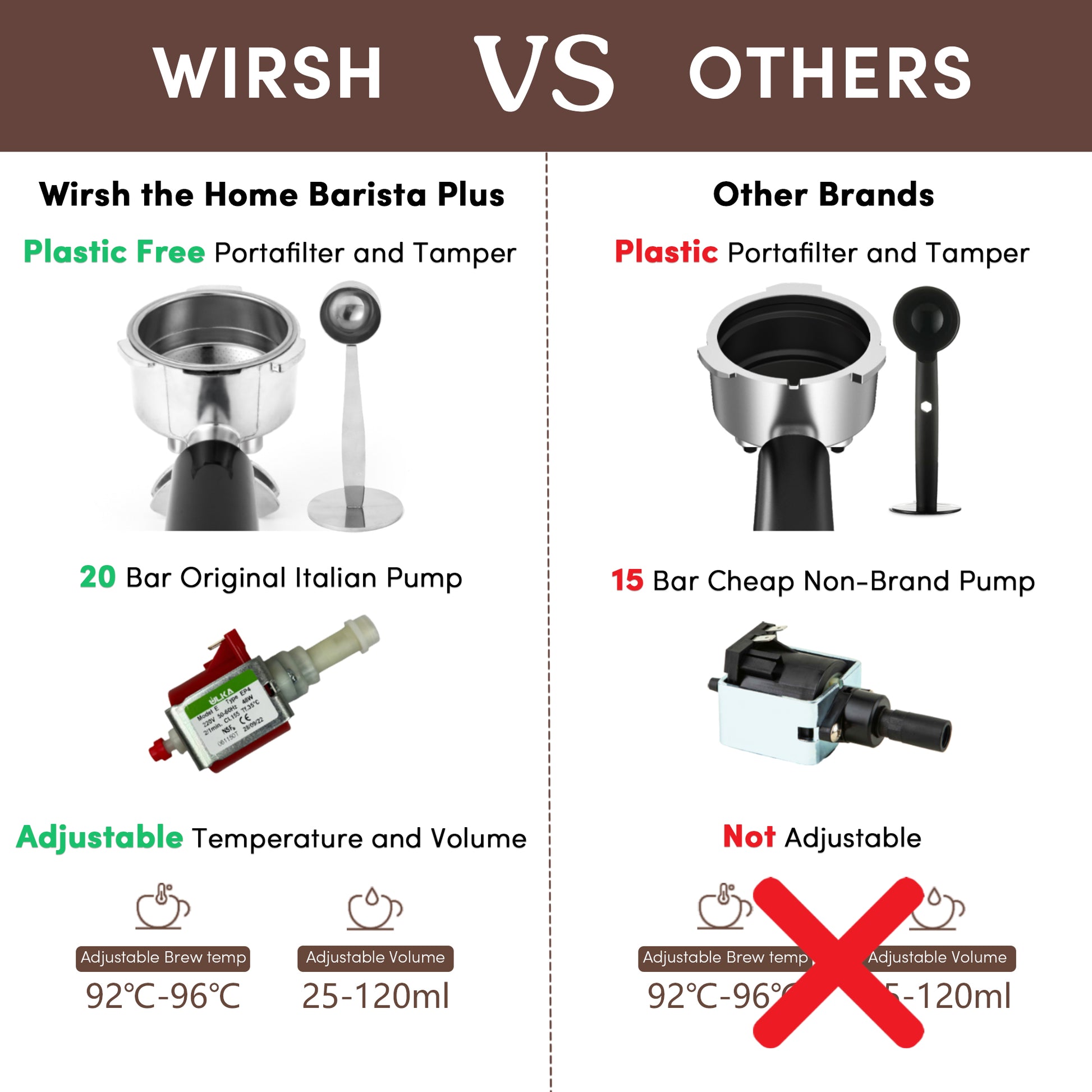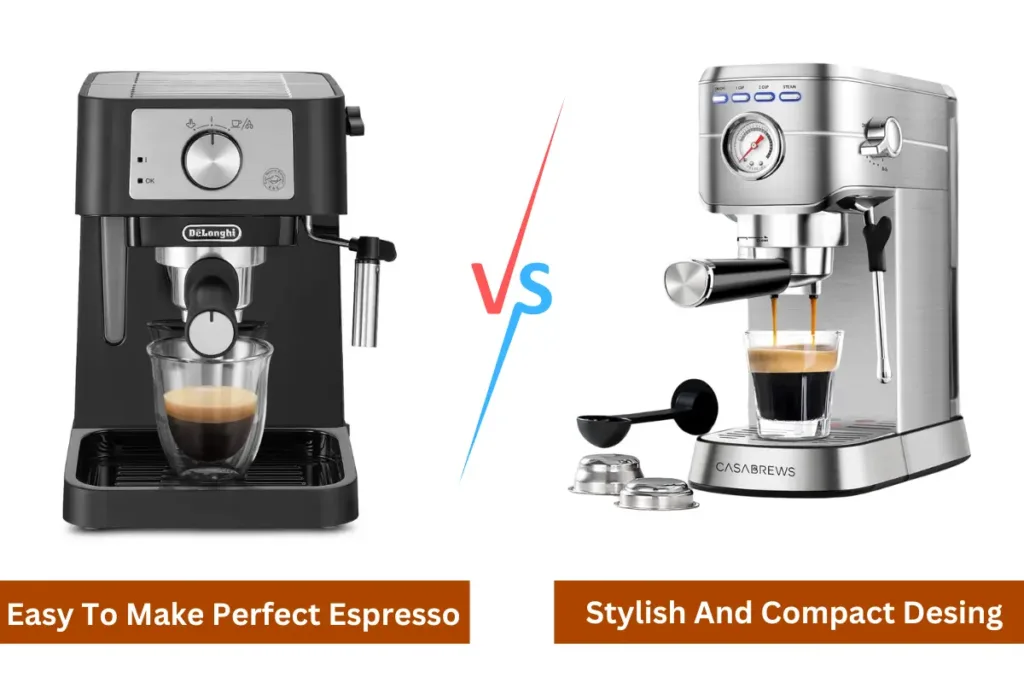A 15-bar espresso machine provides enough pressure for a great shot. A 20-bar machine offers more pressure but isn’t always necessary.
Espresso machines come in various pressure levels, commonly ranging from 9 to 20 bars. The pressure influences the extraction of flavors and oils from coffee grounds. While a 15-bar machine is sufficient for most home baristas, offering a balanced and rich shot, a 20-bar machine may appeal to those seeking more robust flavors.
High pressure can lead to over-extraction if not handled correctly. Therefore, it’s essential to understand your needs and capabilities before choosing between 15 and 20-bar machines. Both options can deliver excellent espresso, but their effectiveness depends on the user’s skill and preference.

Credit: www.aliexpress.com
The Essence Of Brew Pressure In Espresso Making
Understanding brew pressure is crucial in espresso making. The pressure affects the extraction process. It impacts the flavor, aroma, and overall quality. Whether using a 15 bar or 20 bar machine, pressure matters. Let’s dive into how pressure affects your espresso.
The Role Of Pressure In Extraction
Brew pressure pushes hot water through coffee grounds. This process extracts flavors and oils. A standard espresso machine operates at 9 bars of pressure. Higher pressures, like 15 or 20 bars, can influence the extraction.
- 15 bar machines are common for home use.
- 20 bar machines offer more professional features.
Higher pressure can lead to over-extraction. Over-extraction can cause bitter flavors. Lower pressure might under-extract, leading to sour tastes. Finding the right balance is key.
Pressure And Coffee Flavor Profile
Pressure directly affects the coffee’s flavor profile. With 15 bars, you get a balanced extraction. It often results in a smooth and rich taste. For many, this is ideal for a daily cup.
Using a 20 bar machine may intensify the flavors. This can be great for those who love strong espresso. But it requires precise control to avoid bitterness.
Here’s a quick comparison:
| Pressure | Flavor Profile | Best For |
|---|---|---|
| 15 Bar | Balanced, smooth, rich | Home use, daily drinkers |
| 20 Bar | Intense, strong, bold | Experienced baristas, espresso enthusiasts |
Choosing between 15 bar and 20 bar machines depends on your preference. Consider your taste and experience level. Both can produce excellent espresso but with different characteristics.
Diving Into The 15 Bar Espresso Standard
The 15 bar espresso standard is a common benchmark in espresso making. This standard ensures rich, flavorful coffee. Understanding its origins and impact on quality can enhance your coffee experience.
Origins Of The 15 Bar Standard
The 15 bar standard was established by early espresso machine innovators. This pressure level was found to extract the best flavors from coffee grounds. The first commercial espresso machines, created in Italy, used 15 bars of pressure. This became a popular standard for both home and professional machines.
Today, many espresso machines still use the 15 bar standard. This ensures consistency and quality in each cup. Manufacturers follow this benchmark to meet consumer expectations.
How 15 Bar Impacts Espresso Quality
A pressure of 15 bars helps extract the coffee’s essential oils. This results in a rich and full-bodied espresso. The high pressure forces hot water through the coffee grounds quickly. This creates a strong, concentrated shot with a delightful crema on top.
Using 15 bars also reduces the risk of over-extraction. Over-extraction can lead to a bitter taste in your espresso. The 15 bar standard provides a balance, ensuring each shot is flavorful and smooth.
| Pressure Level | Impact on Espresso |
|---|---|
| 15 Bars | Rich flavor, balanced extraction, smooth crema |
| 20 Bars | Potential for over-extraction, stronger taste, thicker crema |
Below is a quick comparison of the benefits of the 15 bar standard:
- Produces a balanced, rich flavor
- Ensures a smooth crema
- Reduces the risk of bitterness
These benefits make the 15 bar standard a popular choice for espresso lovers.
20 Bar Espresso: A Higher Standard
When we talk about espresso machines, the pressure level makes a big difference. A 20 Bar espresso machine represents a higher standard in the coffee world. This machine promises a richer and more flavorful espresso experience.
The Rise Of 20 Bar Machines
20 Bar machines have gained popularity recently. These machines offer higher pressure than the traditional 15 Bar ones. This higher pressure pushes water through the coffee grounds more forcefully. The result is a more intense espresso shot.
Many coffee enthusiasts now prefer 20 Bar machines. They believe these machines extract better flavors. Even some coffee shops have switched to 20 Bar machines. They aim to provide a superior espresso experience to their customers.
Taste And Texture At 20 Bar
What makes a 20 Bar espresso unique? The answer lies in the taste and texture. Higher pressure creates a thicker crema on top of your espresso. This crema is rich and velvety, enhancing the coffee’s flavor.
The taste of a 20 Bar espresso is more complex. You can notice subtle flavors that a 15 Bar machine might miss. The texture is also smoother and more pleasant. This makes every sip enjoyable.
| Comparison | 15 Bar Machine | 20 Bar Machine |
|---|---|---|
| Pressure Level | 15 Bar | 20 Bar |
| Crema Quality | Average | Rich and Velvety |
| Flavor Extraction | Good | Excellent |
20 Bar machines are not just for professional baristas. Home coffee lovers can also benefit. These machines are easy to use and deliver consistent results. Investing in a 20 Bar machine can elevate your daily coffee routine.

Credit: mywirsh.com
Comparing 15 Bar VS 20 Bar Side By Side
Choosing between a 15 bar and a 20 bar espresso machine can be tricky. Both have their unique advantages and affect the coffee differently. Let’s dive deep and compare these two options side by side.
Flavor Differences
The pressure level impacts the flavor of your espresso. A 15 bar machine usually creates a balanced taste. It extracts flavors without overpowering bitterness. On the other hand, a 20 bar machine can produce a richer, more intense flavor. This is due to the higher pressure extracting more compounds from the coffee grounds.
Crema Quality And Quantity
Crema is the golden, foamy layer on top of your espresso. A 15 bar machine typically delivers a good amount of crema. The quality is usually smooth and velvety. With a 20 bar machine, you often get more crema. The texture can be thicker and creamier, adding to the visual appeal and taste.
Extraction Time Variations
Extraction time is crucial for a perfect espresso shot. A 15 bar machine generally has a slightly longer extraction time. This allows for a more gradual flavor development. A 20 bar machine, with its higher pressure, can extract espresso quicker. This results in a faster shot but with a more intense flavor profile.
| Feature | 15 Bar | 20 Bar |
|---|---|---|
| Flavor | Balanced | Richer, Intense |
| Crema | Good amount, smooth | More, thick |
| Extraction Time | Longer | Quicker |
The Science Behind Pressure And Espresso
Espresso lovers often debate 15 bar vs 20 bar espresso machines. Understanding the science behind pressure helps make an informed choice. Pressure plays a crucial role in extracting the perfect espresso shot.
Pressure Dynamics In Espresso Machines
Pressure dynamics in espresso machines impact flavor and crema. Pressure forces hot water through finely ground coffee. This extracts oils, flavors, and aromas. The right pressure ensures balanced and rich espresso.
| Pressure (Bars) | Effect on Espresso |
|---|---|
| 15 Bars | Optimal balance, rich flavor, consistent crema |
| 20 Bars | Potentially bitter, over-extracted, thinner crema |
Optimal Pressure For Espresso Extraction
The optimal pressure for espresso extraction is 9 bars. Most machines use 15 bars to reach this pressure. Too much pressure can over-extract and make the espresso bitter.
A 15-bar machine is typically sufficient. It provides consistent and high-quality espresso shots. Higher pressure, like 20 bars, may complicate the extraction process.
- 15 bars – Ideal for home use, balanced flavor
- 20 bars – More suitable for professional settings
Choosing the right pressure depends on your preference. For most, a 15-bar machine meets their needs perfectly.
Baristas’ Take: Expert Opinions On Pressure
Espresso enthusiasts often debate the ideal pressure for brewing the perfect shot. The common pressures are 15 bar and 20 bar. To understand the best option, we asked professional baristas for their expert opinions.
Professional Insights
Most professional baristas agree that pressure plays a crucial role in espresso quality. They emphasize the balance between pressure and extraction time.
A higher pressure, like 20 bar, might extract more quickly. But this can lead to over-extraction, resulting in a bitter taste. On the other hand, a 15 bar pressure allows for a more balanced extraction. This often leads to a sweeter and more nuanced flavor.
| Pressure Level | Benefits | Drawbacks |
|---|---|---|
| 15 Bar | Balanced extraction, sweeter flavor | Longer brewing time |
| 20 Bar | Faster extraction | Risk of bitterness |
Barista Preferences And Practices
Baristas often have personal preferences based on their experience. Many prefer 15 bar machines for their consistent results. They find that 15 bar machines provide a more reliable brew.
- Consistency: 15 bar machines offer consistent quality.
- Ease of Use: Easier to control extraction time.
- Flavor Profile: Tends to produce a sweeter, more balanced shot.
Some baristas enjoy experimenting with 20 bar machines. They believe that with the right technique, a 20 bar machine can produce exceptional espresso. These baristas often have advanced skills and knowledge.
- Experimentation: Allows for creative brewing methods.
- Advanced Skills: Requires a deep understanding of extraction.
- Potential: Can achieve unique flavor profiles.
Ultimately, the choice between 15 bar and 20 bar comes down to personal preference. Each barista has their own technique and style, shaped by their experiences and taste preferences.
Consumer Reports: User Experiences With Different Pressures
Espresso machines come with various pressure settings. The most common are 15 bar and 20 bar. Many users have shared their experiences online. This section will dive into what users say about these two pressures.
Home Baristas’ Feedback
Home baristas often prefer the 15 bar machines. They say it’s easier to use. Here are some key points:
- Consistency: Users find 15 bar machines offer more consistent shots.
- Ease of Use: Many say 15 bar machines are simpler to operate.
- Flavor: The flavor profile is often balanced and rich.
On the other hand, 20 bar machines also have their fans. Some users like the extra pressure. They believe it extracts more flavors. Here are their thoughts:
- Strength: The espresso is often stronger and bolder.
- Flexibility: Some users enjoy the flexibility of higher pressure.
- Customization: These machines often offer more customization options.
Commercial Settings: Customer Reactions
In commercial settings, customer satisfaction is crucial. Let’s see what customers say about their espresso experiences in cafes and restaurants.
| Pressure | Customer Feedback |
|---|---|
| 15 Bar |
|
| 20 Bar |
|
In cafes, the choice between 15 bar and 20 bar machines can affect customer satisfaction. Both pressures have their unique advantages. The key is to match the machine to customer preferences.
Choosing The Right Pressure For Your Espresso
Choosing the right pressure for your espresso can be daunting. The difference between 15 bar and 20 bar machines is significant. Understanding these differences can help you make the best choice for your coffee needs.
Factors To Consider
The pressure level affects espresso quality. Higher pressure can extract more flavors. But it can also lead to over-extraction. Here are some key factors to consider:
- Flavor Extraction: 15 bar machines offer balanced flavors. 20 bar machines can extract richer, deeper flavors.
- Consistency: Higher pressure can lead to more consistent shots.
- Ease of Use: 15 bar machines are often easier for beginners. 20 bar machines may need more skill.
Machine Selection And Investment
Choosing between 15 bar and 20 bar machines depends on your needs. Here are some points to keep in mind:
| Criteria | 15 Bar Machines | 20 Bar Machines |
|---|---|---|
| Price | Generally more affordable | Often more expensive |
| Skill Level | Beginner-friendly | Requires more experience |
| Flavor Profiles | Balanced and smooth | Richer and deeper |
| Maintenance | Less complex | It may require more maintenance |
Investing in a 20 bar machine can be worthwhile for enthusiasts. For everyday use, a 15 bar machine might suffice. Consider your budget and your love for coffee. This will guide your choice.
Technical Considerations For Machine Maintenance
Maintenance is crucial for any espresso machine, whether 15 Bar or 20 Bar. Proper upkeep ensures consistent performance and extends the machine’s lifespan. Below, we explore key technical considerations for maintaining these machines.
Pressure Calibration
Pressure calibration is vital for optimal espresso extraction. Both 15 Bar and 20 Bar machines need regular checks.
- Use a pressure gauge to measure the output.
- Adjust the pump to maintain the ideal pressure.
- Ensure the machine is off and cooled before calibration.
Incorrect pressure affects espresso quality. Regular calibration helps maintain the best flavor.
Longevity And Wear
Longevity and wear are influenced by the machine’s pressure rating. Higher-pressure machines may wear out faster.
| Machine Type | Average Lifespan | Common Wear Issues |
|---|---|---|
| 15 Bar | 5-7 years | Valve leaks, pump failures |
| 20 Bar | 3-5 years | Seal degradation, pump wear |
Regular cleaning and timely part replacements can extend the machine’s life.
The Verdict: Balancing Quality And Practicality
Choosing between a 15 bar and a 20 bar espresso machine can be confusing. Each has its own set of advantages and disadvantages. The right choice depends on balancing quality and practicality.
Summarizing The Debate
15 bar espresso machines are widely recommended by experts. They offer consistent pressure and good coffee extraction. 20 bar machines promise higher pressure. This can sometimes lead to over-extraction. It’s crucial to understand the mechanics behind these machines. Most commercial espresso machines operate at 9 bars. Therefore, higher bars don’t always mean better coffee.
| Aspect | 15 Bar | 20 Bar |
|---|---|---|
| Pressure | Consistent | Higher |
| Extraction | Optimal | Can Over-extract |
| Industry Standard | Common | Less Common |
Personal Preferences Vs. Industry Standards
Personal preferences play a big role in this decision. Some people prefer the strong flavor from a 20 bar machine. Others like the balanced taste from a 15 bar machine. Industry standards lean towards 15 bar machines. They are reliable and provide consistent results. 20 bar machines are more for experimental coffee lovers.
Consider your daily coffee needs. If you want reliable and consistent coffee, go for a 15 bar machine. If you enjoy experimenting with flavors, try a 20 bar machine. Ultimately, the best machine is the one that meets your needs. Balance quality and practicality for the best coffee experience.
Frequently Asked Questions
Is 15 Bar Or 20 Bar Espresso Better?
15 bar is sufficient for excellent espresso. 20 bar doesn’t significantly improve quality. Focus on machine quality and technique.
Is 15 Bars Of Pressure Too Much For Espresso?
No, 15 bars of pressure is not too much for espresso. It provides optimal extraction for rich flavor.
What Does 20 Bar Mean On An Espresso Machine?
“20 bar” on an espresso machine indicates the pressure level. It means the machine can generate up to 20 bars of pressure, essential for extracting rich espresso. High pressure ensures better flavor and crema. The ideal pressure for brewing espresso is around 9 bars.
What Is The Best Bar Pressure For Espresso Machine?
The best bar pressure for an espresso machine is 9 bars. This ensures optimal extraction and flavor.
Conclusion
Choosing between a 15 bar and 20 bar espresso machine depends on your needs and preferences. Both can deliver great espresso. Consider your budget, taste, and machine features. Remember, the pressure alone doesn’t guarantee quality. Experiment and find what suits you best for that perfect cup of espresso.

